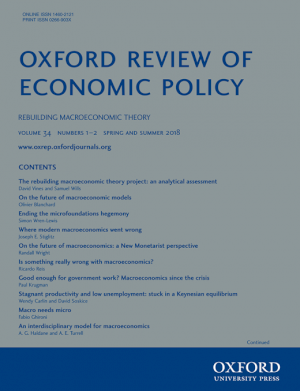11 April 2018
Rebuilding Macroeconomic Theory
Oxford Review of Economic Policy, Volume 34, Numbers 1‑2, Spring‑Summer 2018. ISSN 0266‑903X
David Vines, Samuel Willis
2018, Oxford Academic,
Reviewer: Kevin Gardiner

You wait thirty years for a critical paper on the state of macroeconomics by an established academic economist, then fourteen come along at once. The Spring and Summer 2018 issues of the Oxford Review of Economic Policy are given over to them.
The authors include some of the biggest names in the academic firmament. Dry prose can’t hide some deep-seated disagreements. But they have more in common than they realise.
They mostly take it for granted that models – whether primarily axiomatic or statistical in nature – are central to the macro research programme. The discussion is insular and incremental, there is little epistemological insight or interest, and no sign of an intellectual hinterland or a wider curiosity. There is one female name amongst the eighteen cited authors and co-authors. These are papers about boys’ toys.
My spirits did leap when I saw the word “interdisciplinary” in the title of one of the papers, but it was immediately followed by “model”, and outlined an approach as doomed to irrelevance as most of the others.
Not for the first time, the best macro insights come from the US. Joseph Stiglitz refers in passing to success enjoyed by economists using “less fully articulated models” – and with this casual phrase nails the problem: macro modellers are attempting too much. Paul Krugman too suspends his partiality and usefully reminds us that precision in macro is spurious, and that forecasting is not the same as understanding.
The Global Financial Crisis is seen as a watershed by several authors. But we have long known – or should have known – that an endogenous money supply is prone to seizure, that central banks do not always control interest rates, and that banking supervision is part of monetary policy.
We may never be able usefully to model the creation and destruction of liquidity in a modern economy. What we lacked in 2008 were not better theory or models, but better data: who loaned what to whom, and on what terms (you’re doing what with that credit default swap?). Even if we’d had it, bad stuff can always happen: markets can be emotional.
David Hendry and John Muellbauer, who have always shown more interest than most econometricians in where their data comes from, acknowledge another practical difficulty encountered in trying to offer useful macroeconomic advice: how to choose among the various independent variables.
Suppose, for example, you believe that wealth matters for consumer behavior. Theory can tell us little about whether this means cash at hand, direct holdings of securities, assets tied up in pension funds, or total wealth including housing.
If we chose net wealth, do we deduct all debt, or just short-term credit? Most writers on the “debt crisis” of course don’t trouble themselves with these details but simply add up all the gross liabilities they can find and assert that the world is insolvent.
These simple, unexciting but important practicalities may not be resolvable, no matter how much maths we throw at them. Econometricians’ favourite preoccupations, such as the wild goose chase of dynamic specification, seem insignificant by comparison.
Many of the papers focus on modelling consumer spending. They have to, because both “Keynesians” (who seem to prefer a “structural” approach to economic modelling) and “new classical” camps (who seem to favour “Dynamic Stochastic General Equilibrium” models) focus on the expenditure side of national accounts. Apologies if I have mislabeled the two camps, or overlooked some others, but it really doesn’t matter.
Completely missing from the debate is any feel for – or indeed interest in – business. Profitability barely features, and capital spending is assumed (in 2018!) to be driven by “Tobin’s Q”. Competitiveness is considered only from the demand-side, and is largely a function of the real exchange rate.
Several of the authors assert that macroeconomics is about equilibrium. It is if you’re conditioned to think in those terms. And the importance of (unmodellable) expectations surely makes it possible for there to be multiple solutions and occasionally none at all.
Perhaps Milton Friedman is partly to blame for all this, with his influential assertion that a theory’s value is independent of the realism of its assumptions. This paved the way for rational expectations, exogenous money supplies and risk premia – but also for Q-driven investment and simultaneous equations.
I suspect we know less than we think about macro, but also that there is less to be known than we think. Macroeconomics is useful, but it has more in common with plumbing than physics. Its academic practitioners just need to get out more.
